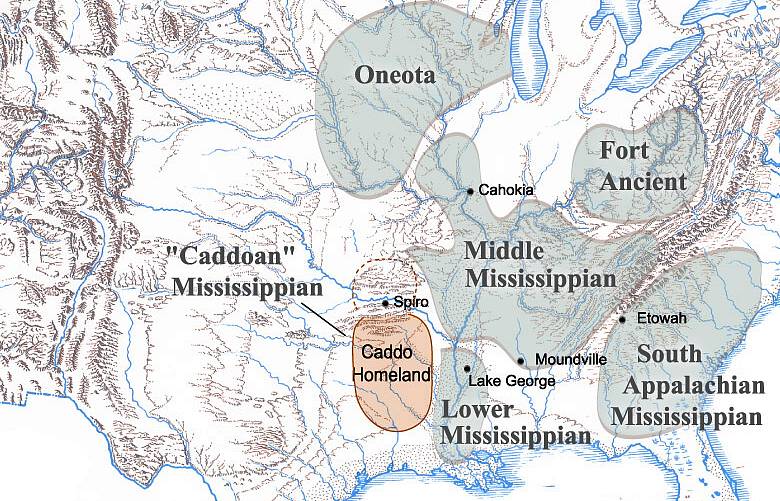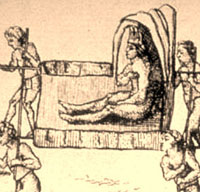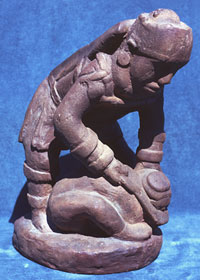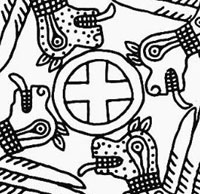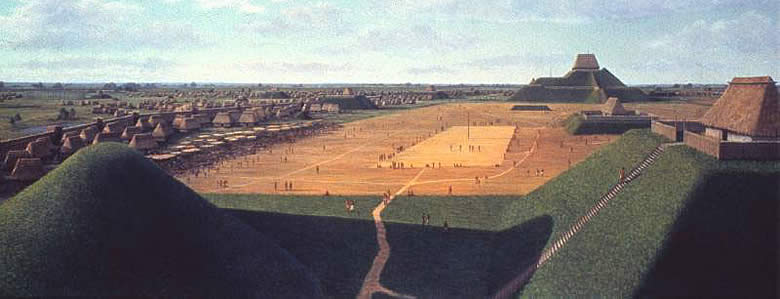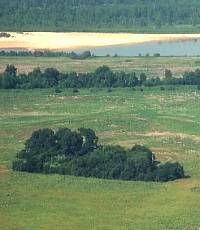
Aerial view of Battle Mound, the
largest mound in the Caddo Homeland and one of the largest
in the Southeast, measuring some 670 feet in length,
320 feet wide, and 34 feet high. In the background is
the Red River. Photo courtesy Frank Schambach.
|
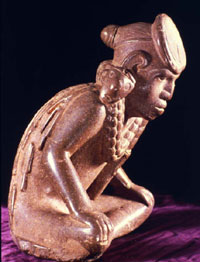
Stone effigy pipe from the Craig
Mound at Spiro. It has been called "Big Boy"
and "Resting Warrior," but neither of these
labels convey the status that this person—real
or mythical—surely had in the Mississippian world.
The figure may represent the mythical character known
as Red Horn among many historic Indian groups (see opposite
panel).
The pipe is made from red flint clay mined near Cahokia.
Recently, it has been hypothesized that this sacred
object and others like it were made in the 12th century
and used at Cahokia. When the power of that great site
waned in the late 13th century, important sacred objects
like this pipe were taken to other sites like Spiro
and Gahagan.
The seated figure wears a pair of long-nosed god mask
earrings. On his back is a feathered cape, similar to
those found in fragmentary condition at Spiro. Around
his neck are heavy strings of beads. On his head is
a curious cap that archeologist James Brown believes
served to display embossed copper plates. (26 centimeters
high or about 10 inches.) From the collections of the
University Museum, University of
Arkansas. Photo courtesy Pictures of Record.
|

"Bird-man" depicted on
a repoussé copper plate from the Etowah site,
Georgia. (Repoussé is a technique used to create
raised designs by hammering a thin metal sheet from
its back.) In this example the bird-man seems to be
a human dancer wearing a falcon costume. A human head
appears to be dangling by its scalp from the bird-man's
left hand. Bird-man figures are a common representation
in Mississippian ritual art.
|

This wooden statue from Craig Mound
at Spiro may be a representation of an ancestor like
those seen by early European visitors in temples and
charnel houses in the Southeastern U.S. (32.5 centimeters
high) Smithsonian Institution.
|

Conch shell gorget from the Sanders
site in the Red River Valley in Lamar County, Texas.
The depiction of severed human heads is a common theme
in Mississippian symbolism. The Sanders site dates mainly
to the Middle Caddo period, about A.D. 1200-1400, and
seems to have had a special relationship with Spiro,
the nature of which is debated. More Southern Cult objects
are known from the Sanders site than any other Caddo
center south of Spiro. TARL archives.
|
|
Among the hundreds of ritual centers across
the Mississippian world, most were relatively small and contained
only a few mounds. A few among them stood out as primate
centers. These places were the biggest of the big, the
political and ritual centers of complex and unusually successful
chiefdoms. The largest and most powerful of them all was the
Cahokia site in the central Mississippi Valley near present
day St. Louis. Cahokia had perhaps 200 earthen mounds and
may have been home to as many as 15,000 people at its height
around A.D. 1150. To the southeast were Moundville, in northern
Alabama, and Etowah, in northern Georgia, both the largest
sites in their local regions and both peaking 100-150 years
after Cahokia. In the lower Mississippi Valley, the sites
of Winterville and Lake George had dozens of mounds and were
larger than all others in the region. The westernmost major
center was the site of Spiro in the Arkansas Valley.
The best candidate for a primate center in the
main Caddo Homeland is the Battle site in southwest Arkansas
in the Great Bend area of the Red. This site contains the
largest mound in the Caddo Homeland and one of the largest
in the Southeast, measuring some 670 feet in length, 320 feet
wide, and 34 feet high. The only other known mounds at the
Battle site were four very low rises (now leveled for agriculture),
but there are numerous cemeteries, occupation areas, and mounds
in the general vicinity that may well have been part of the
greater Battle community. Unfortunately, the site has only
seen minor investigation and remains little known. The absence
of obvious primate centers in the main Caddo Homeland may
reflect, at least in part, the nature of Caddo settlement
patterns: people lived in dispersed communities more often
than nucleated villages. There are numerous smaller ritual
centers in the Caddo Homeland that probably served as the
central places of small, independent polities (political units)
that some would call chiefdoms.
Although never politically united, the Mississippian
world was united in a cultural sense by participation in widespread
religious and social phenomena often described as "cults."
This is perhaps a poor choice of terms as the word cult may
conjure up images of small extremist groups. Mississippian
"cults" were part of very powerful and widespread
religious movements that we are only beginning to understand.
The best-known Mississippian religious movement
is popularly known as the Southern Cult, although most
archeologists today prefer the less evocative phrase Southeastern
Ceremonial Complex. The central tenets of this cult or
religion were transmitted through rituals and through the
exchange of sacred objects emblazoned with symbols such as
falcons, crosses, and rattlesnakes. Often the iconography
depicts scenes of violence and warfare, such as warrior figures
holding weapons and decapitated heads. These symbols were
carved, modeled, engraved, and painted on many materials,
most of them probably perishable (like cloth and wood) or
made from exotic materials, such as copper and marine shell,
imported from distant sources.
The Southern Cult was exclusive—only certain
individuals and kin groups participated, thus supporting the
authority of the chiefs. They alone could handle, wear, and
own the most sacred symbols, which were no doubt perceived
as possessing power and being too dangerous for any but the
chosen few to handle. When the leaders died, the cult artifacts
were buried with them, perhaps to protect the people from
danger. (Or, to take a more pragmatic interpretation, to keep
such symbols out of general circulation, and thus rare and
more prestigious.) By exchanging these symbolic artifacts
among one another, the leaders also maintained trading and
political alliances. Such alliances were important because
warfare appears to have been widespread.
Among the Southern Cult artifacts that do survive,
carved marine shell gorgets (chest ornaments) and drinking
cups, are the most widely distributed. Many shell ritual objects
were made from lightning whelk shells from the northern Gulf
coast. The cups were used in rituals during which participants
consumed the famous "black drink," a dark tea made
from yaupon leaves. Much misinformation exists about the black
drink. Its principal active ingredient is caffeine. Early
European visitors to the Southeast were appalled when they
witnessed what could be called "projectile vomiting"
during rituals involving the consumption of the black drink.
This purposeful ritual purging or cleansing was induced by
drinking lots of hot tea quickly, not by the properties of
the tea. Yaupon bears the scientific name Ilex vomitoria,
a name born out of European misunderstanding.
There is also good evidence for the existence
of a widespread Earth Cult (for lack of a better term)
that was tied to renewal, fertility, and the periodic building
of earthen mounds. This set of beliefs was communal in nature
and served to bring people together to participate in community-wide
rituals. Periodically, temples and other special buildings
were carefully dismantled or burned and buried with a fresh
layer of earth, often chosen for its color and texture. Burial
mounds received similar treatment: periodic renewal by the
addition of new layers of earth.
Some archeologists, including Dee Ann Story
and Frank Schambach, think that for the Caddo what was most
important was not the mounding of earth, per se, but what
the earth was mounded over—ritually destroyed temples
and tombs. Referring to the burning of temples, Schambach
believes that "for the Caddo, one immediate objective
of this ritual may have been to produce the great plume of
smoke and steam that must have emanated from each burned and
buried building for days or even weeks, as a cord or more
of wood was slowly reduced to charcoal." He reasons that,
to the Caddo, fire and smoke were the key elements,
not earth, an idea that finds support in early historic accounts
of the importance of fire to Caddo groups.
Earth, fire, or smoke, the timing of such ritual
activities was probably tied to the agricultural cycle and
perhaps to longer ritual cycles linked to the death of important
chiefs or astronomical phenomena. Major ritual events almost
certainly included feasting, dancing, and other communal activities.
The third widely shared religious practice was
Ancestor Veneration. Showing respect for exalted ancestors
took many forms, including elaborate burials such as the shaft
tombs of the Caddo and mounds where only certain members of
society were buried. Most Caddo groups were unusual among
Mississippian societies in that they buried their dead quickly
while their bodies were still intact. Most other societies
in the Eastern Woodlands had charnel houses where bodies were
stored until the flesh had rotted (or had been removed by
priests) and only bones were left. Periodically, the charnel
houses were cleaned out and the accumulated bones buried together
during elaborate rituals, perhaps also linked to renewal.
Another widespread indication of ancestor worship is the existence
of temples containing human statues made of stone or wood
and some times sacred bundles or boxes containing the bones
of a revered ancestor or special ritual items. These are best
known from the accounts of early European explorers, although
human statues made out of wood, ceramics, and stone have been
found at Spiro and other Mississippian sites.
Mississippian iconography often seems to glorify
war and victory over vanquished foe. But as far as we can
tell, most Mississippian warfare was more akin to raiding
or ritual warfare, rather than all-out conquest. Most conflicts
were probably raids to kill or capture warriors for revenge
or arranged battles of limited scope. Nonetheless, the presence
of fortified towns, particularly in the Mississippi Valley,
suggests that people had reason to fear. Warrior motifs are
often found on the engraved shells and other symbolic artifacts.
Armed figures holding human head and scenes of decapitation
and human sacrifice leave little doubt that military victories
were glorified. Unambiguous archeological evidence of ritual
cannibalism support eyewitness accounts of early explorers.
Mississippian life was sometimes violent and gruesome.
The Caddo Homeland was on the geographical and
cultural edge of the Mississippian world. As far as we can
tell, ancestral Caddo groups never established large, complex
chiefdoms, with the possible exception of Spiro. Instead the
Caddo world was one of relatively small-scale chiefdoms of
the sort described by the Spanish and French chroniclers.
The largest Caddo centers had less than a dozen mounds, usually
far less. With the notable exception of Battle Mound, most
Caddo earthworks are small by comparison to those at major
Mississippian centers, and tiny by comparison to Cahokia.
Caddo centers were also laid out less formally and more organically
than major Mississippian centers and they lacked fortifications.
What accounts for these differences? The location
of the Caddo Homeland on the western frontier of the Eastern
Woodlands is clearly a major factor. Most of the river valleys
of the Caddo Homeland pale in size and productivity in comparison
to the Mississippi and its major tributaries where many of
the Mississippian developments took place. It is no accident
that the largest and most complex Mississippian society developed
at Cahokia in the central Mississippi valley. In the same
way, Spiro is in the Arkansas Valley and, to the south, most
of the larger Caddo centers occur along in the Great Bend
region of the Red River, the largest and most fertile of the
waterways in the main Caddo Homeland. Another consequence
of being on the Mississippian frontier is that Caddo groups
did not have any neighboring competing chiefdoms to contend
with (at least to the west), which probably helps explain
why Caddo sites were not fortified.
The other major factor seems to have been the
nature of Caddo societies themselves. Caddo societies seem
to have split apart before becoming too large. We can speculate
that Caddo societies developed mechanisms for sharing food
and wealth and for "social leveling" — keeping
high and low ranking classes (or clans) from being too segregated.
Rigid caste-like social classes like those of the Natchez
do not appear to have existed among the historic Caddo. Still,
Caddo societies were not egalitarian; they had marked social
inequalities as described in early historic accounts, and
seen in differences in house size and location within archeological
sites, in differences in comparative size and wealth among
sites, and in differences in grave elaboration.
|

Battle Mound, the largest known Caddo
mound, is in southwest Arkansas. Note person standing
in front of tree-covered mound. Photo courtesy Tim Perttula.
|
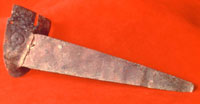
Long-nosed god mask earring from
the Gahagan Mound site in northwest Louisiana. One of
a matched pair found within a mass of artifacts in the
corner of an Early Caddo tomb, the earring is made of
sheet copper. The pair probably represent ritual ear
ornaments as depicted on the effigy pipe from Spiro
shown opposite.
Long-nosed god depictions are known from many North
American and Mesoamerican cultures. Anthropologist Robert
Hall has linked the Mississippian-period long-nosed
god with the mythical figure known as Red Horn or He-who-wears-human-heads-as-earrings
to the historic Winnebago and Iowa Indians of the upper
Midwest. Hall believes the mask earrings were part of
adoption rituals in Mississippian society during which
important leaders extended fictive kinship bonds to
visiting leaders, thus cementing political alliances.
Photo courtesy Pictures of Record.
|

Marine shell (lightning whelk) drinking
cup from cemetery burial at the Haley site on the Red
River in southwest Arkansas. In Mississippian societies,
shell drinking cups were used in rituals during which
participants consumed the famous "black drink,"
a dark, caffeine-rich tea made from yaupon leaves. Photo
courtesy Pictures of Record.
|
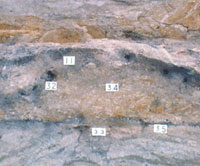
Cross-section through a temple mound
at the Ferguson site, a Late Caddo site dating to about
A.D. 1400 that is located in the Little Missouri River
Valley in southwest Arkansas. The burned layers near
the bottom of the picture are the remains of a small
temple that was purposefully collapsed, then burned
and intentionally buried. Photograph courtesy of Pictures
of Record.
|
|
The Mississippian world was never uniform or united;
instead it was fragmented and fractious, a 600-year
era during which dozens of chiefdoms arose and then
fell apart.
|
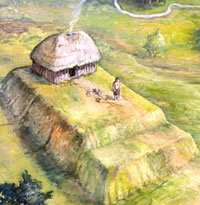
Artist's depiction of a dispersed
Caddo settlement in what is today southeastern Arkansas.
The house on the rectangular earthen mound in the foreground
is that of a chief or shaman; the mound caps the remains
of earlier houses of important people. Scattered in
the background are family compounds, some with both
winter (rectangular) and summer (round) houses as well
as raised storage bins where surplus corn was stored.
All of the details are based on archeological and historical
evidence. Courtesy Arkansas Archeological Survey.
|
|
